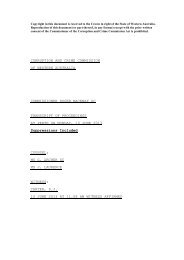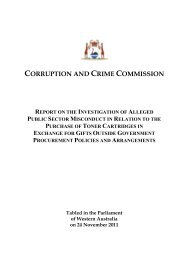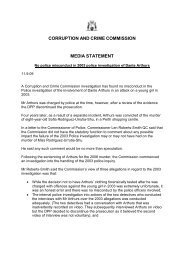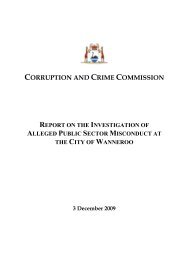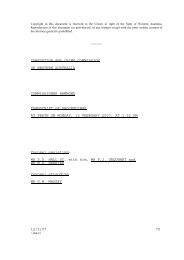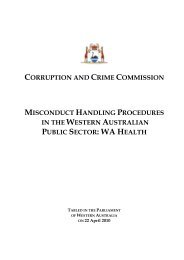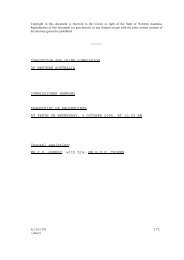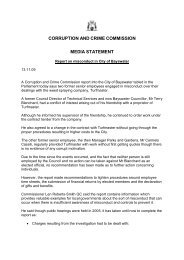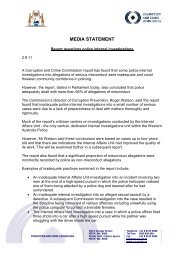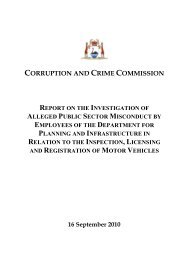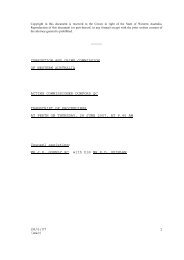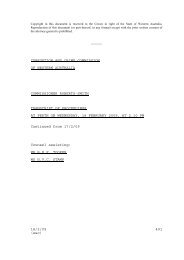Misconduct Resistance Framework - Corruption and Crime ...
Misconduct Resistance Framework - Corruption and Crime ...
Misconduct Resistance Framework - Corruption and Crime ...
Create successful ePaper yourself
Turn your PDF publications into a flip-book with our unique Google optimized e-Paper software.
What is the integRation guide?<br />
The Integration Guide is a practical starting point, designed to help you implement the <strong>Misconduct</strong> <strong>Resistance</strong><br />
<strong>Framework</strong> in your agency. It is targeted at managers <strong>and</strong> others in specialist positions who have responsibility for<br />
the development, implementation <strong>and</strong> monitoring of agency misconduct resistance strategies.<br />
The guide contains detailed information about each outcome <strong>and</strong> provides a methodology for achieving these<br />
outcomes. The key elements underpinning the outcomes each have a set of Focus Questions <strong>and</strong> Signs of<br />
Success, with supporting Ideas to Build Capacity for each outcome area.<br />
The guide also includes a reference <strong>and</strong> resource section to help you access more detailed information should<br />
you need to.<br />
FOCUS QUESTiONS identify some of the potentially relevant issues that your agency may need to consider<br />
against the key elements. They are designed to help you evaluate how comprehensive <strong>and</strong> effective your current<br />
strategies are, <strong>and</strong> to help identify areas that may need further attention.<br />
SiGNS OF SUCCESS are descriptions of the types of results your agency should be working towards for a particular<br />
key element. They provide examples of what could be seen in agencies that have successfully implemented a key<br />
element.<br />
iDEAS TO BUiLD CApACiTy have been provided for each outcome to help your agency improve management<br />
of a specific issue where a gap or need has been identified. These ideas represent some commonly used<br />
countermeasures, actions <strong>and</strong> strategies that you can implement.<br />
The questions, signs <strong>and</strong> ideas are not exhaustive <strong>and</strong> simply provide a broad-based reference model.<br />
you should customise your use of the guide to capture your agency’s unique business environment <strong>and</strong> needs.<br />
ReMeMBeR<br />
the guide is not<br />
An audit or compliance checklist that must be strictly<br />
followed.<br />
A prescriptive method for addressing the key<br />
elements.<br />
A sequential list of activities.<br />
A definitive list of all questions <strong>and</strong> issues to be<br />
addressed.<br />
A one-size-fits-all model for how to integrate<br />
misconduct resistance.<br />
The only way to approach implementation of<br />
misconduct resistance.<br />
Intended to provide all the right questions or answers.<br />
A m<strong>and</strong>atory document.<br />
the guide is<br />
A place to start when considering how to integrate<br />
misconduct resistance.<br />
An overview of the key elements for your agency to<br />
address.<br />
A prompt of the issues <strong>and</strong> areas to consider.<br />
A reference from which to select areas needing<br />
attention.<br />
A generic model that can be customised to reflect your<br />
agency’s unique business <strong>and</strong> risk environments.<br />
A source of ideas for building capacity where a need<br />
is identified.<br />
A guide for obtaining further information <strong>and</strong><br />
resources.<br />
<strong>Misconduct</strong> is a significant business risk for all public sector agencies, <strong>and</strong> the costs of failing<br />
to manage it effectively can be severe. In a 2006 survey, KPMG found that 47% <strong>and</strong> 32% of<br />
Australian businesses, including the public sector, respectively reported fraud <strong>and</strong> unethical<br />
conduct by staff. The most commonly reported conduct risks (after fraud) were misuse of<br />
resources, false sick claims <strong>and</strong> disclosures of information.<br />
KPMG Forensic Fraud Survey 2006.



